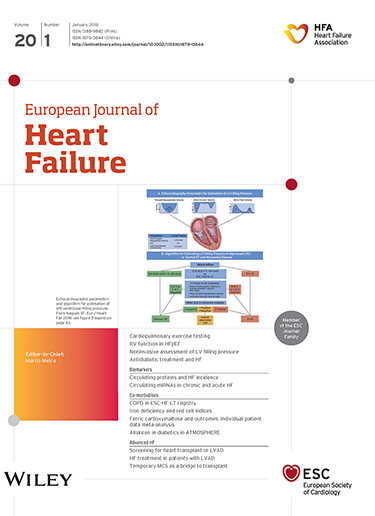Rationale and design of the TRIC-I-HF-DZHK24 (TRICuspid Intervention in Heart Failure) trial.
IF 10.8
1区 医学
Q1 CARDIAC & CARDIOVASCULAR SYSTEMS
引用次数: 0
Abstract
AIMS Tricuspid regurgitation (TR) is a detrimental disease frequently diagnosed in patients with right-sided heart failure (HF). While transcatheter tricuspid valve interventions (TTVI) effectively reduce TR and improve quality of life (QoL) in earlier stages of the disease, their effect on reducing HF hospitalizations (HFH) and improving survival remains unclear. METHODS TRIC-I-HF-DZHK24 (NCT04634266) is an investigator-initiated, prospective, randomized, open-label, multicentre strategy trial. Approximately 360 patients with severe TR and manifest right-sided HF will be enrolled. In contrast to previous trials, subjects with increased risk for HFH will be selected as facilitated by specific inclusion criteria: HFH in the previous year, or presence of cardio-renal syndrome, or evidence for cardio-hepatic syndrome. Subjects will be randomized 2:1 to TTVI and optimal medical therapy (OMT) or continuation of OMT alone. All CE-marked transcatheter repair devices including tricuspid transcatheter edge-to-edge repair (T-TEER) or transcatheter tricuspid annuloplasty can be used for TTVI. The participating 29 study sites are highly experienced and treated a mean of 176 patients in 4.5 years with T-TEER before study activation. The primary outcome will be assessed at 1 year. First, a composite of all-cause mortality, HFH, and QoL improvement will be tested hierarchically. If positive, the combination of hard clinical endpoints including all-cause mortality and HFH will be tested. Patients will be followed for a total of 3 years. The safety outcome comprises complications of TTVI, life-threatening bleeding and death. CONCLUSIONS The TRIC-I-HF-DZHK24 trial will define the role of TTVI in patients with severe TR and right-sided HF.trici - i - hf - dzhk24(心力衰竭三尖动脉干预)试验的基本原理和设计。
右心衰(HF)患者常发生的一种有害疾病——非瓣瓣反流(TR)。虽然经导管三尖瓣干预(TTVI)在疾病早期有效降低TR和改善生活质量(QoL),但其对减少HF住院率(HFH)和提高生存率的作用尚不清楚。strict -i - hf - dzhk24 (NCT04634266)是一项研究者发起的前瞻性、随机、开放标签、多中心策略试验。大约360例严重TR和明显右侧HF患者将被纳入研究。与以前的试验相比,将根据特定的纳入标准选择HFH风险增加的受试者:前一年患有HFH,或存在心肾综合征,或有心肝综合征的证据。受试者将按2:1随机分配至TTVI和最佳药物治疗(OMT)或继续单独的OMT。所有有ce标志的经导管修复装置,包括三尖瓣经导管边缘到边缘修复(T-TEER)或经导管三尖瓣环成形术均可用于TTVI。参与的29个研究中心经验丰富,在研究启动前,平均在4.5年的时间里使用T-TEER治疗了176名患者。主要结果将在1年进行评估。首先,对全因死亡率、HFH和生活质量改善的综合指标进行分层检验。如果呈阳性,将检测硬临床终点的组合,包括全因死亡率和HFH。患者将被随访3年。安全性结果包括TTVI并发症、危及生命的出血和死亡。trici - i -HF- dzhk24试验将明确TTVI在严重TR和右侧HF患者中的作用。
本文章由计算机程序翻译,如有差异,请以英文原文为准。
求助全文
约1分钟内获得全文
求助全文
来源期刊

European Journal of Heart Failure
医学-心血管系统
CiteScore
27.30
自引率
11.50%
发文量
365
审稿时长
1 months
期刊介绍:
European Journal of Heart Failure is an international journal dedicated to advancing knowledge in the field of heart failure management. The journal publishes reviews and editorials aimed at improving understanding, prevention, investigation, and treatment of heart failure. It covers various disciplines such as molecular and cellular biology, pathology, physiology, electrophysiology, pharmacology, clinical sciences, social sciences, and population sciences. The journal welcomes submissions of manuscripts on basic, clinical, and population sciences, as well as original contributions on nursing, care of the elderly, primary care, health economics, and other related specialist fields. It is published monthly and has a readership that includes cardiologists, emergency room physicians, intensivists, internists, general physicians, cardiac nurses, diabetologists, epidemiologists, basic scientists focusing on cardiovascular research, and those working in rehabilitation. The journal is abstracted and indexed in various databases such as Academic Search, Embase, MEDLINE/PubMed, and Science Citation Index.
 求助内容:
求助内容: 应助结果提醒方式:
应助结果提醒方式:


